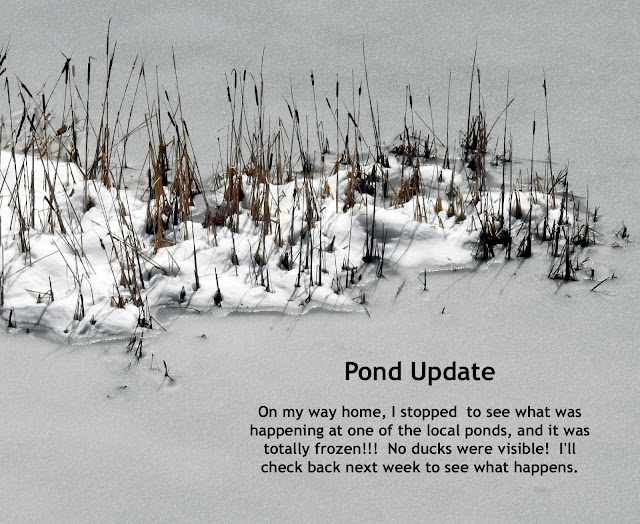Last Friday I went on a road trip to the Sonoran Desert in Arizona. While I was gone, a late winter storm dumped 3 feet of heavy wet snow in our neighborhood!!! The power was knocked out for 6 days! The total amount of precipitation for the week was 6.19", which brings our water year total to 27.63". When I got back home, there was two feet of heavy, wet, packed snow on the ground and it's still here! Although this last storm caused a lot of damage and power outages, we are all thrilled that the threat of fires has been reduced. More snow and rain is predicted for the coming week! Fingers crossed that wet weather keeps coming for the next month and more!
Our Feeding Station
Project FeederWatch Update!
Project FeederWatch ends in two weeks, on April 3rd. So far I've seen 17 species of birds, with an average of 40+ birds per day. The regular winter visitors to our feeding station were approximately 50 Dark-eyed Juncos, 18 Mountain Quail, 16 Steller's Jays, 4 Mourning Doves, 2 Spotted Towhees, 2 Fox Sparrows, 2 Northern Flickers, and 1 Song Sparrow. Just this week most of these birds have increased in number, and several new species of birds have shown up! The Dark-eyed Juncos, Mountain Chickadees, and the Mountain Quail will migrate to higher elevations as the weather improves. The Red-winged Blackbird will migrate to agriculture or pasture land. The Varied Thrushes, Golden-crowned Sparrows, and White-crowned Sparrows, will migrate north as far as Alaska to mate. The rest of the birds stay here for the entire year.
I have had a fun season watching birds, and contributing data to the Cornell Lab this year! I'll stop feeding the birds in April and will probably resume in November for the next, citizen science, Project FeederWatch season. Project FeederWatch is sponsored by The Cornell Lab and Birds Canada. The following quote is from their website at feederwatch.org.
"Project FeederWatch turns your love of feeding birds into scientific discoveries. FeederWatch is a winter-long (November-April) survey of birds that visit feeders at backyards, nature centers, community areas, and other locales in North America. Participants periodically count the birds they see at their feeders and send their counts to Project FeederWatch. Your bird counts help you keep track of what is happening in your own backyard and help scientists track long-term trends in bird distribution and abundance. With FeederWatch, your observations become part of something bigger."
Pipilo maculatus - Passerella iliaca
Varied Thrush (female - male)
Ixoreus naevius
Turdus migratorius - Junco hyemalis
Zenaida macroura - Columba fasciata
Golden-crowned Sparrow - White-crowned Sparrow
Zonotrichia atricapilla - Zonotrichia leucophrys
Mountain Quail - Northern Flicker
Oreortyx pictus - Colaptes auratus
Song Sparrow - Pine Siskin
Melospiza melodia - Spinus pinus

Steller's Jay - Brewer's Blackbird
Cyanocitta stelleri - Euphagus cyanocephalus
Red-winged Blackbird (male) - Mountain Chickadee
Agelaius phoeniceus - Poecile gambeli
Beavertail Cactus - Opuntia basilaris
I'll post my Sonoran Desert Blog next weekend!
What new birds have arrived?
Where are the mammals?
Check back next week for the answers to these questions and more!
Unfortunately you can no longer sign up to get my blog emailed to you.
Something changed at Blogspot.com. Oh well...
Your questions and comments are greatly appreciated!
Please email me at northyubanaturalist@gmail.com












No comments:
Post a Comment